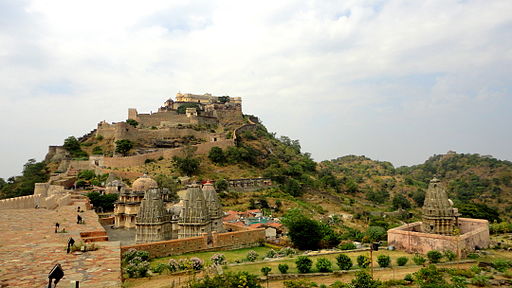Long and serpentine, the walls of the fort of Kumbhalgarh are the second longest continuous wall in the world, after the Great Wall of China.
Extending for over 36 km, the walls of this fort are impenetrable. It was a stunning surprise to know that this is the worldʼs second man-made structure that can be seen from outer space, satellite images to boot. My first glimpse of the fortress left me wanting for more. Our guide, dressed in typical Rajasthani attire including a pagadi (or pagda, as he called it) on his head, took us to this elevated place from where the winding fortification could be seen for kilometres. It seemed so unconquerable that I wondered how the enemies would even plan a battle against this kingdom, let alone enter this massive fortress. Lo! My contemplation was spot-on when our guide endorsed that Kumbhalgarh fort is one of the most inaccessible fortifications ever built by humans. Dated back to the 15th century, this fort was the creation of Maharana Kumbha, the great king of the Mewars. The fort derives its name from its creator, Kumbha, and is a representative of the past glory of the Rajput rulers. Walking inside the huge fort complex that has several palaces, impressive ramparts, temples and gardens, the panoramic view of the countryside from its turrets was magical. And it got better as we climbed higher.
FORTIFIED TO THE HILT
Even today, centuries later, the Kumbhalgarh fort looked so impregnable that in the heydays it must have been the enemy’s envy. Touching some of the brick and mortar on the walls, it was clear that neither weather nor the passage of time had eroded them much. A true example of defensive architectural marvel, this fort in Rajasthan was built in 1443 CE. It snakes along 13 mountain peaks, has seven fortified gateways with seven ramparts folded with one another, huge watchtowers and 15 ft-thick front walls. Not having enough, Rana Kumbha chose to build this fort on an unassailable hill, 1,914 m above sea level. No wonder, this fort is called ʻThe Mountain Fortress,ʼ having the natural advantage of the Aravali ranges surrounding it. Its an admirable fact in Indian history that this fort was captured only once, that too when the Mughal emperor Akbar had its water supply poisoned. Residents of the fort faced acute shortage of water and succumbed to the attacks.

The majestic Kumbalgarh Fort (Photo by Hemantisbest)
THE POLS
Pol was a word I stumbled upon many times in the Kumbhalgarh fort — at every arch or entrance — Bagga Pol, Chaugan Pol, Ram Pol, Aaret Pol, Halla Pol, Pagda Pol, to name a few. Pol, in those days, meant gates. Each pol opened up to one part of the fort and signified something. For instance, Aaret Pol had the watch tower, Halla Pol expected people to maintain silence and at Pagda Pol, men were supposed to remove their pagdas as a mark of respect to the king, as this gate led to the king’s arena. It got me thinking, what would Nimboo Pol signify?
THE FAIRY TALE PALACES
The fort, built in accordance with the Vastu Shastra, appears like the ones described in fairy tales — perhaps due to the gorgeous palaces atop the hills — the palace of Rana Kumbha and Badal Mahal or the ‘palace of clouds.’ Badal Mahal is so called because the clouds seem just at arm’s length during monsoon. Marking the birthplace of Maharana Pratap, the great king of the Mewars, this palace is a favourite with visitors. The Rajputani style used to build this palace is so exquisite and thorough in its creation that I stood gazing in awe. Its rooms have a beautiful choice of colour — green, white, turquoise and blue — offering a delightful contrast to the earthy hues of the fort. Do not miss looking out from the wooden windows to see the breathtaking view of the Aravali range. In fact, this palace underwent a remarkable make-over when Rana Fateh Singh, who reigned in the late 19th century, rebuilt it, bringing to it more character and grandeur.

The view of Kumbalgarh Fort (Photo by Sajaldhiman)
TEMPLES GALORE
I would not doubt the immense belief that the Rajputs had in their Gods — why not, when they had 360 odd temples built inside the Kumbhalgarh Fort — with 300 of them being ancient Jain temples and the rest belonging to Hindu gods. One of the temples of Shiva I went into, had a huge, white shivling — the pinkish red rays of sunlight fell on it such that they accentuated the features of the shivling. The orange dhoti-clad priest added to the colourful contrast.
LEGEND HAS IT
Rajasthan does have a admirable way of ensuring every visitor gets to know the state’s history. Every evening, at sunset, they have a Light & Sound Show inside the fort — where the tales from the Mewar period are narrated. And an interesting legend surfaced. It seemed Rana Kumbha had many unsuccessful attempts at building the fort wall, which is when a spiritual guru stepped in and advised that a human sacrifice would take care of whatever was causing the impediment. He told the king that if a temple were built at the place where the head should fall and the wall of the fort be built where the rest of the body lay, then the fort wall would stand tall. After a long wait for a volunteer, a pilgrim (some say, a soldier) surfaced for the cause and was ritually decapitated. Magical as it may seem, this time around, Rana Kumbha succeeded in completing the fort wall! In honour of this sacrifice, the main gate of the fortress, Hanuman Pol, has a shrine devoted to the pilgrim.

Kumbalgarh Fort at Night (Photo by Kunal)
NIGHT LIGHTS
The show lit up the fort splendidly and I was trying hard to photograph this enthralling experience even as the tripod swayed in the breeze. It brought to life a truly glorious era of Rajasthan wherein ideals, honour, sacrifice and chivalry ruled supreme. The splendor of The Kumbhalgarh Fort was a sight to remember — a precious opportunity to witness the second largest wall in the world that was built to withstand every attack. They say that on the orders of Rana Kumbha, 50 kg of ghee and 100 kg of cotton was used everyday to light up massive lamps and provide light to farmers. Golden times!
About the author
Kasturi loves to escape into the wilderness every now and then and when she is away, music is her only companion.



